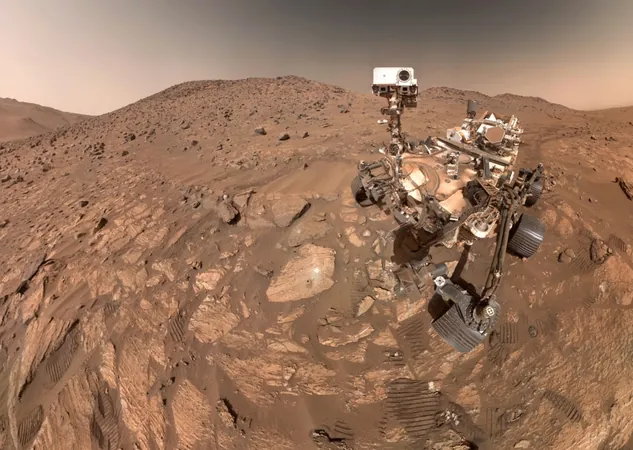
Revolutionizing Astronomy: Earth's Largest Camera Set to Transform Our View of the Universe
2025-07-07
Author: Emma
Unveiling the LSST Camera in Chile
Nestled atop a mountain in Chile, where the skies are perpetually clear, a groundbreaking astronomical mission is underway. Scientists and engineers, including Kshitija Kelkar, are preparing to exploit the power of the LSST Camera— the largest digital camera ever made. This camera marks a pivotal moment in the quest to understand our cosmos.
From Passion to Profession: Kshitija Kelkar's Journey
Kshitija's fascination with astronomy began humbly. Two decades ago, she sent a photo of a lunar eclipse from her digital camera to the prestigious magazine 'Sky and Telescope.' It was published as the 'Photo of the Week' and ignited her passion for the field. Fast-forward to today, and she is now an observing specialist at the Vera C. Rubin Observatory, utilizing the colossal camera that released awe-inspiring images of distant galaxies and celestial phenomena.
Unprecedented Discoveries Await
On June 23, the LSST Camera sent shockwaves through the scientific community with stunning images of galaxy clusters and nebulae. One astonishing capture showcased a nebula approximately 4,000 light years away, all rendered in exquisite detail. Over an astonishing 10-hour period in May, the observatory also identified over 2,100 previously unknown asteroids, a feat made possible by its rapid imaging capabilities.
The Power of the Rubin Observatory
This observatory is not merely a competitor to existing giants like the James Webb or Hubble telescopes; it complements them beautifully. Unlike Webb, which focuses on specific targets, the Rubin Observatory is a survey telescope, designed to paint a comprehensive picture of the night sky. Its snapshots cover areas equivalent to 40 full moons—far superior to the limited view from other telescopes. In just its initial test run, Rubin captured an astounding image revealing 10 million galaxies.
10 Years of Cosmic Cinematography: The LSST Project
The LSST's primary instrument, the Simonyi Survey Telescope, is set to embark on a remarkable 10-year journey known as the Legacy Survey of Space and Time (LSST). This ambitious project aims to map the visible universe in unprecedented detail, effectively creating the largest time-lapse film of the cosmos. By continuously capturing 30-second images, the telescope will document changes in the night sky, unveiling new celestial interactions.
Advancements in Real-Time Asteroid Detection
As Kelkar points out, the Rubin Observatory is on track to revolutionize asteroid detection, potentially identifying more in a single year than all other telescopes combined. The innovative design allows swift adjustments to capture any celestial activity, making it an astrophysical sentinel. Scientists globally are eagerly monitoring the alerts for the newly detected asteroids, hoping to gain insights into cosmic events.
A New Era in Astrophysics
The bold mission of the LSST Observatory marks a watershed moment in astrophysics. As Kelkar puts it, this telescope embodies a common dataset for diverse astronomical research—no need for specialized observations. With a decade-long project that could alter our understanding of the universe, astronomers are poised for potentially groundbreaking discoveries, perhaps even evidence of extraterrestrial life.
Looking Ahead: Cosmic Revelations Await
As the Rubin Observatory gears up for its 2025 launch, the excitement in the astronomical community is palpable. Kelkar reflects on the decades of hard work leading to this moment and anticipates the wonders awaiting us.
"We're about to create a magnificent 10-year movie of the night sky with the fastest telescope ever built. It's going to be a monumental leap for humanity and our understanding of the universe!"









 Brasil (PT)
Brasil (PT)
 Canada (EN)
Canada (EN)
 Chile (ES)
Chile (ES)
 Česko (CS)
Česko (CS)
 대한민국 (KO)
대한민국 (KO)
 España (ES)
España (ES)
 France (FR)
France (FR)
 Hong Kong (EN)
Hong Kong (EN)
 Italia (IT)
Italia (IT)
 日本 (JA)
日本 (JA)
 Magyarország (HU)
Magyarország (HU)
 Norge (NO)
Norge (NO)
 Polska (PL)
Polska (PL)
 Schweiz (DE)
Schweiz (DE)
 Singapore (EN)
Singapore (EN)
 Sverige (SV)
Sverige (SV)
 Suomi (FI)
Suomi (FI)
 Türkiye (TR)
Türkiye (TR)
 الإمارات العربية المتحدة (AR)
الإمارات العربية المتحدة (AR)